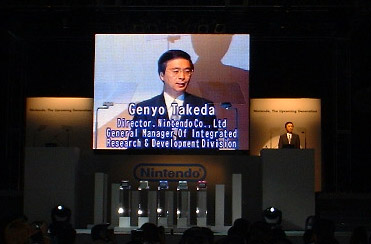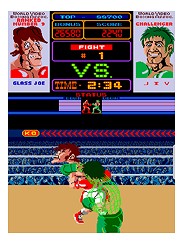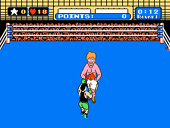

 A year after the R&D2 team,Nintendo decided to form the R&D3 team.
Research & Development 3 was formed from a mix of tech savvy experts,
and software programmers. Nintendo's R&D3 was run by newly designated
General Manager, Genyo Takeda. R&D3 was responsible for much of the
technical hardware design for the later arcade boards, and the Famicom
/ Nintendo Entertainment System. R&D3 was responsible for technical
designs like the bank switching, and later the many MMC chips Nintendo
used inside its NES cartridges. Besides being the primary group when it
came to hardware technology and hardware tools, R&D3 also would moonlight
as a video game development team. Whenever R&D3 had enough free resources,
it would develop its own line of videogame software. R&D3's first projects
included an arcade game titled Punch-Out!!.
A year after the R&D2 team,Nintendo decided to form the R&D3 team.
Research & Development 3 was formed from a mix of tech savvy experts,
and software programmers. Nintendo's R&D3 was run by newly designated
General Manager, Genyo Takeda. R&D3 was responsible for much of the
technical hardware design for the later arcade boards, and the Famicom
/ Nintendo Entertainment System. R&D3 was responsible for technical
designs like the bank switching, and later the many MMC chips Nintendo
used inside its NES cartridges. Besides being the primary group when it
came to hardware technology and hardware tools, R&D3 also would moonlight
as a video game development team. Whenever R&D3 had enough free resources,
it would develop its own line of videogame software. R&D3's first projects
included an arcade game titled Punch-Out!!.
...
Genyo Takeda and R&D3 produced the last two
original arcade projects with Super
Punch-Out!!and Arm
Wrestling. Nintendo saw the future with the success of Atari, and it
was in the home console market.
...
 In
the meantime, Genyo Takeda's less prolific R&D3 didn't do too shabby,
either. They were without a doubt the smallest R&D video game maker
at Nintendo, all while having split responsibilities between software and
hardware support. The development group did, however, come up with some
very popular franchises such as Mike Tyson's Punch-Out!! and the
tropical-themed adventure Star Tropics. R&D3 also specialized in Nintendo's
line of sports games; the team developed Ice Hockey, Pro Wrestling, and
NES Play Action Football amongst other titles. Many of those games went
on to sell extremely well worldwide. One thing very different from Takeda's
software focus, is that it was aimed at the American market. Infact, several
of Takeda's games either sold horribly in Japan, or Nintendo never bothered
releasing them.
In
the meantime, Genyo Takeda's less prolific R&D3 didn't do too shabby,
either. They were without a doubt the smallest R&D video game maker
at Nintendo, all while having split responsibilities between software and
hardware support. The development group did, however, come up with some
very popular franchises such as Mike Tyson's Punch-Out!! and the
tropical-themed adventure Star Tropics. R&D3 also specialized in Nintendo's
line of sports games; the team developed Ice Hockey, Pro Wrestling, and
NES Play Action Football amongst other titles. Many of those games went
on to sell extremely well worldwide. One thing very different from Takeda's
software focus, is that it was aimed at the American market. Infact, several
of Takeda's games either sold horribly in Japan, or Nintendo never bothered
releasing them.
Personals:
Head of R&D 3, Takeda's most notable achivement
is the battery back up memory. The idea is to allow players to save games
on
a cartridge, without this innovation Miyamoto's
"The Legend of Zelda" would have been impossible. The idea behind the Battery
back-up RAM was to harness the capability of
the writability of RAMs (RandomAccessMemory). However RAM loses its
stored data once power is cut, a long life battery
was added to supply power to the RAM even if the cartridges are unpluged
and
stored and therefore allows the data in the RAM
to be kept as it is even if no external power is available to supply the
RAM chip
with power. His R&D team also made many advancements
in chip technology wich made possible the graphical sophistication of
many NES games in its later years. Takeda's most
recent achivement is the design of the Analog controller for the Nintendo
64
which has already set an industry wide standard.
Competitors Sega and Sony were left scrambling to release an analog pad
for
their respective 32-bit systems.
|
|
|